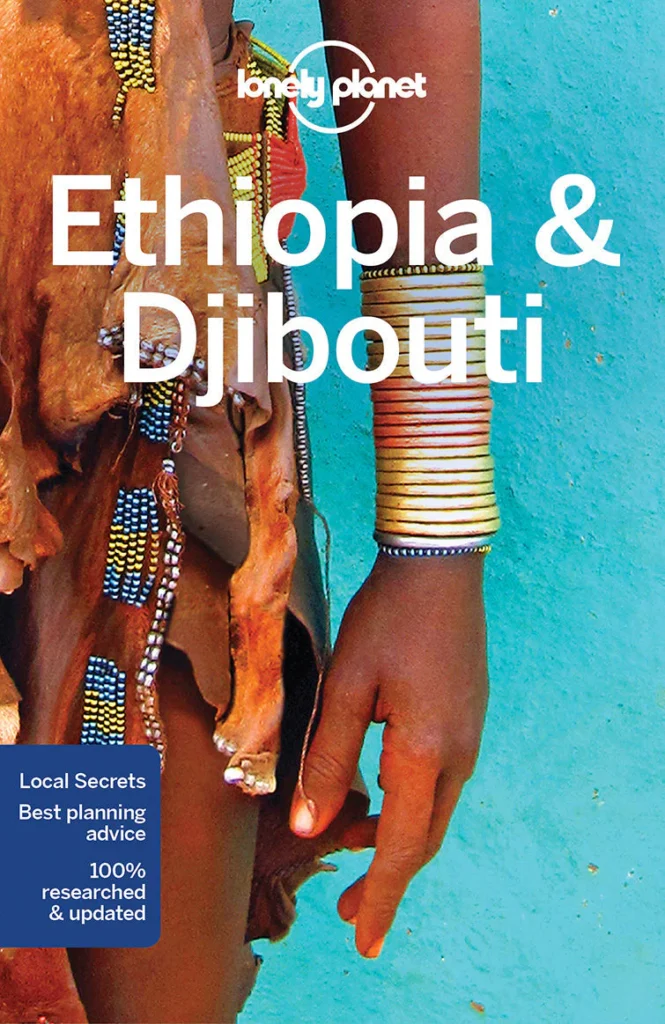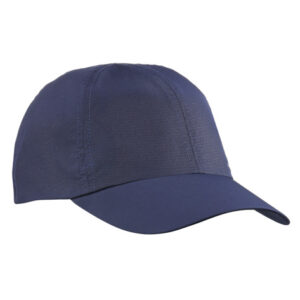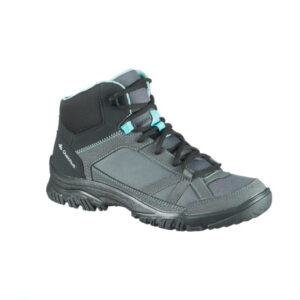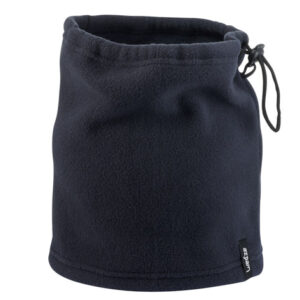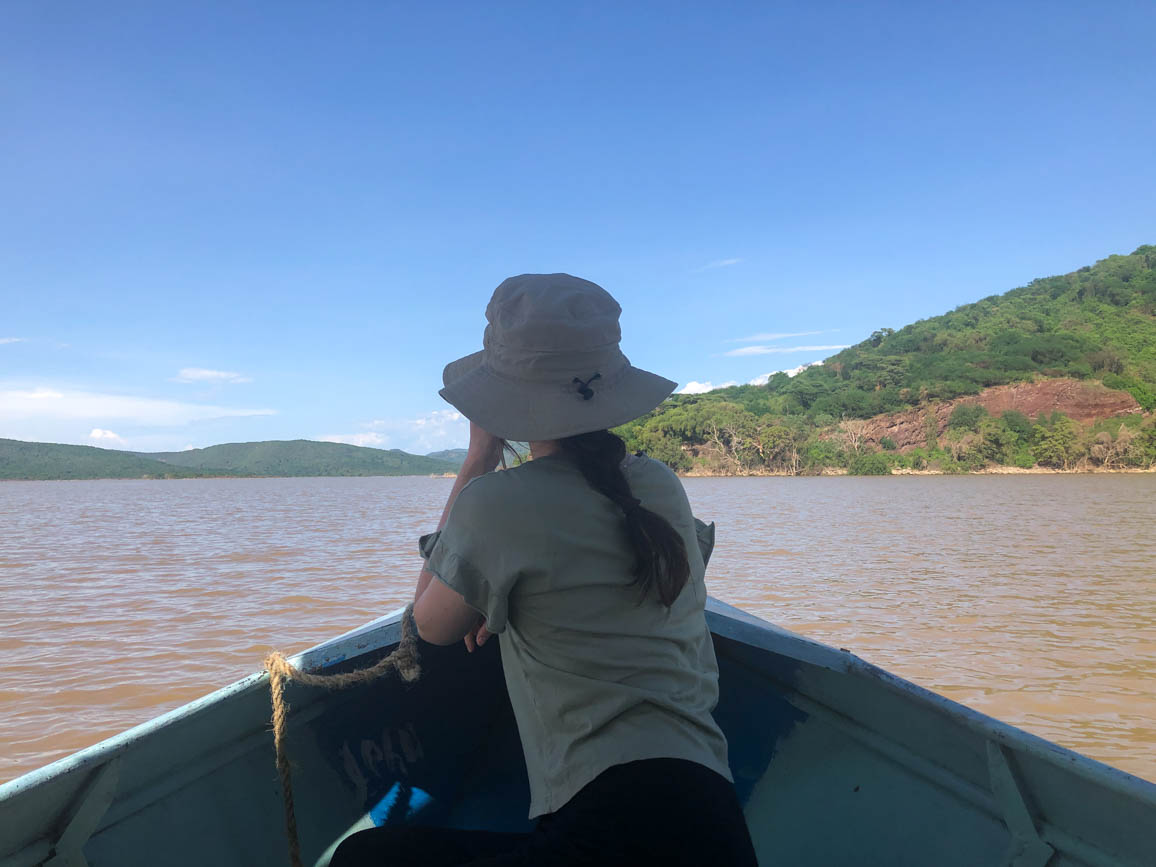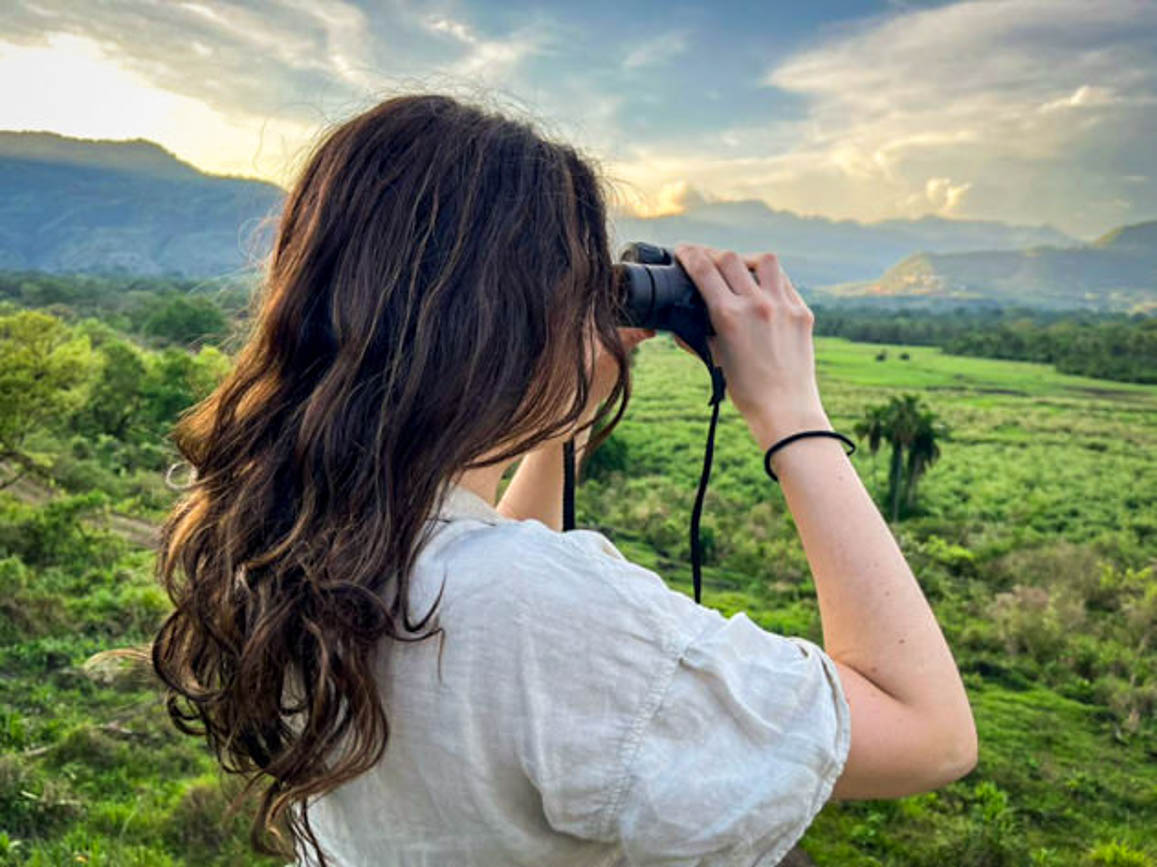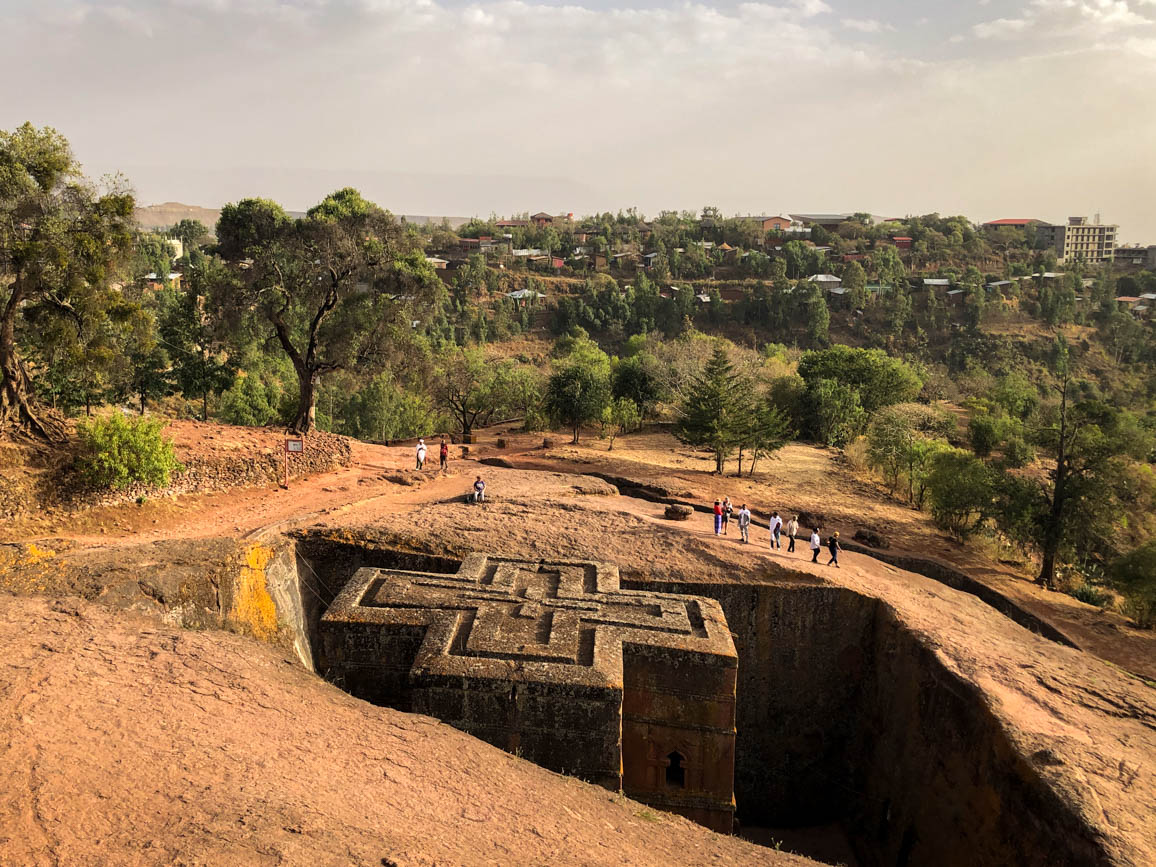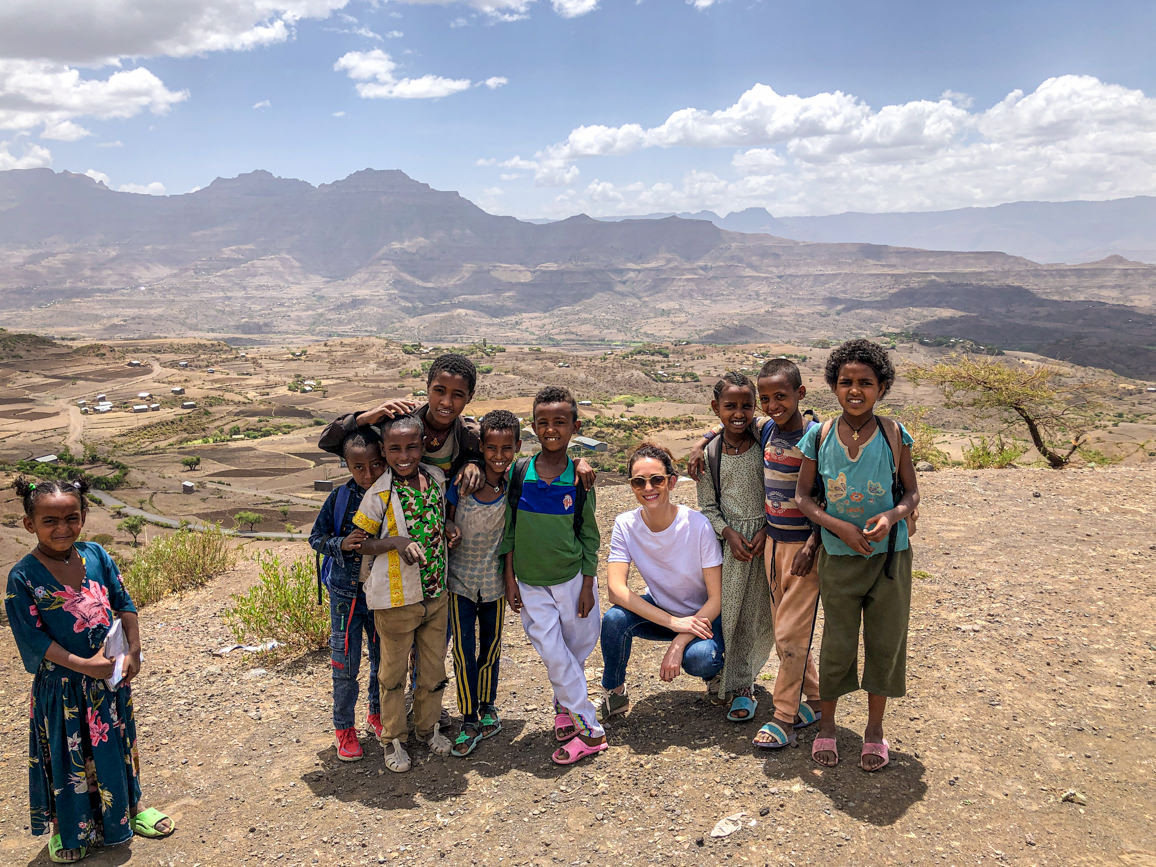
After months of planning and dreaming about this trip, I finally managed to visit Ethiopia with a couple of friends from my days in Washington, D.C.. It was a memorable adventure to say the least! Unsurprisingly, this landlocked African country has a lot to offer, from ancient heritage and fascinating culture, to breathtaking landscapes and delicious food. In this post, you will learn more about our Ethiopian itinerary and what you can see and do there in two weeks. It also includes a section with frequent questions that you may have before traveling to the country. Finally, you will find a map too, so you can easily pinpoint where we went. I hope it will inspire you to visit this unique destination soon!
***
***
Throughout the trip, I used this Ethiopia & Djibouti guidebook by Lonely Planet to plan our stay and make the most out of it. I hope you’ll find it helpful too!
Browse my Ethiopia destination page for more content about this fascinating country!
Exploring southern Ethiopia: ethnic tribes of the Omo Valley & safaris in national parks
Ethiopia trip highlights: my top 7 experiences
Lalibela, a mystical UNESCO World Heritage site
What to do in Addis Ababa, the bustling capital of Ethiopia
What to do in Ethiopia: our 2-week itinerary
Our 2-week stay in the country had three distinct parts.
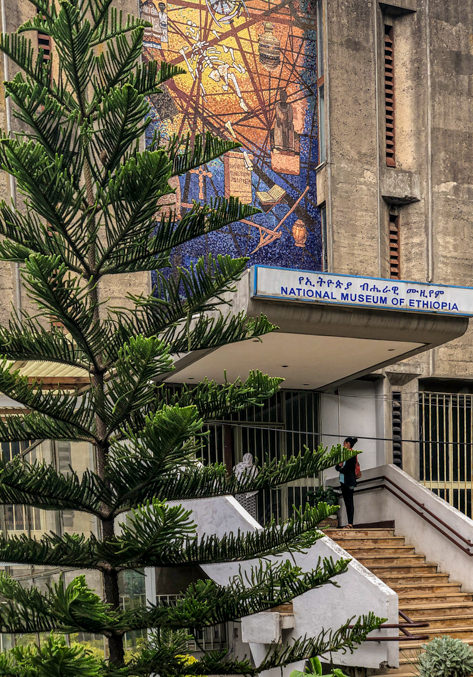
First, we spent a few days in the capital city of Addis Ababa, which was our base at the beginning, middle and end of our trip. While we were there, we visited some of the highlights such as the National Museum of Ethiopia housing our 3.5 million old ancestor Lucy, the vast Meskel Square or Unity Park. We also had fun shopping, trying traditional restaurants such as Yod Abyssinia, and taking it easy while drinking great coffee.
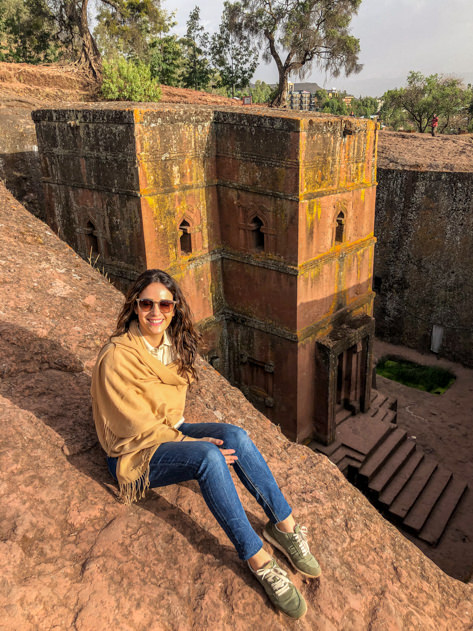
The second stop in our Ethiopia itinerary was Lalibela for two days and a half. Located in the north and considered the spiritual center of the country, the must-sees here are the iconic rock-hewn churches. These are the main treasure of Ethiopian Orthodox Christians and are an exceptional architectural marvel.
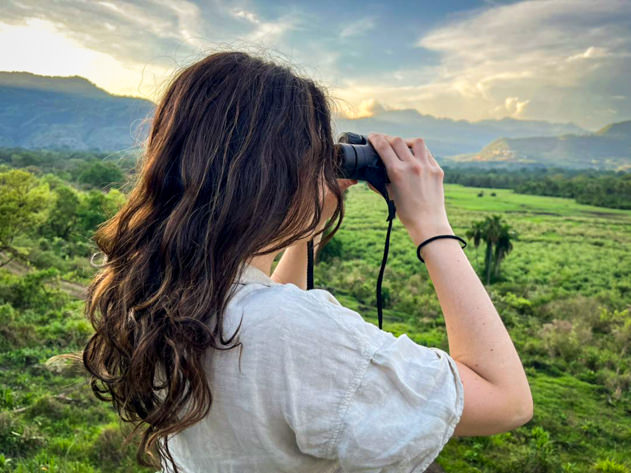
Finally, we devoted most of our time (ten days) to exploring southern Ethiopia, discovering some local tribes in the Omo Valley (Ari, Mursi, Bana, Kara, Dorze), incredible wildlife (from elephants and baboons, to warthogs and guinea fowls) and beautiful national parks (Chebera-Churchura, Maze, Mago, Nech Sar and Abyata-Shalla). It was truly memorable!
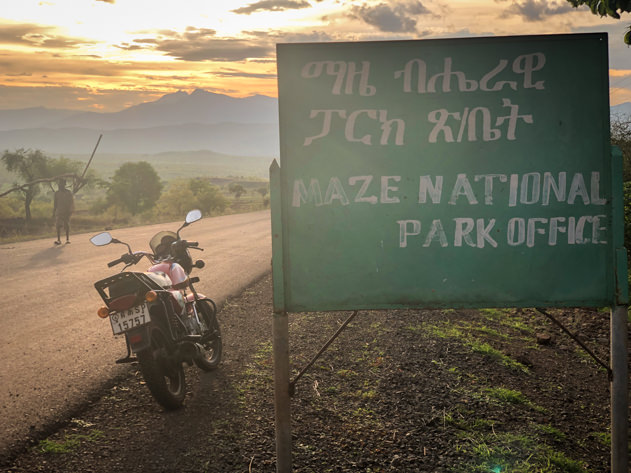
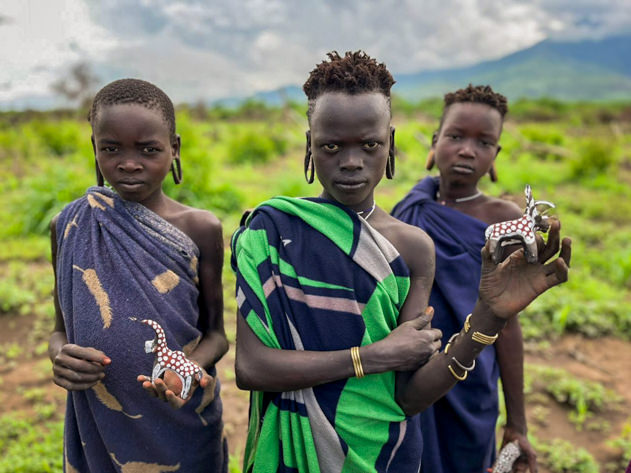
Let’s see our Ethiopian itinerary in more detail:
- Day 0: flight from Bilbao to Istanbul (where I met one of my friends), and connection to Addis Ababa (we landed there past midnight).
- Days 1 and 2: explore Addis Ababa, the capital of Ethiopia, where we slept at our friend’s house.
- Days 3, 4 and 5: fly to Lalibela to visit the famous rock-hewn churches in this UNESCO World Heritage Site, and return back to Addis. Accommodation and meals at Sora Lodge Lalibela.
- Day 6: road trip from Addis Ababa to Jimma. Overnight at Awetu Grand Hotel.
- Days 7 and 8: Chebera-Churchura National Park. Accommodation at Chebera Safari Lodge.
- Day 9: Maze National Park. Overnight camping.
- Day 10: arrival to Jinka, our base to explore the Omo Valley, and visit to the Ari tribe. Stay at the Nassa Hotel for two nights.
- Day 11: Mago National Park and visit to the Mursi tribe.
- Day 12: drive to Turmi and visit to the Kara tribe. Overnight at Buska Lodge.
- Day 13: drive to Konso and boat trip around the Nech Sar National Park. Accommodation at Paradise Lodge in Arba Minch.
- Day 14: visit of Arba Minch, lake Abaya and the Dorze tribe before arriving to Hawassa. Overnight at Lewi Hotel Piazza.
- Day 15: Hawassa, Abyata-Shalla National Park and return to Addis, before flying back to Istanbul and then off to Bilbao.
Even though our Ethiopia itinerary lasted two weeks and you might want to use it as an inspiration, you could of course adjust it to your own liking. If you were to shorten it and spend a week in the country, I would suggest you pick and choose from the above-mentioned destinations (for example, Addis, Lalibela and somewhere else). On the other hand, if you decided to lengthen your stay in Ethiopia, you could add far more attractions including Aksum/Axum, Bahir Dar, lake Tana and the Blue Nile Falls, Gondar, the Bale and Simien Mountains or the Danakil Depression and the active Erta Ale volcano.
In sum, I would advise spending at least ten days in Ethiopia to get a glimpse of this vast and diverse country. In case you can stay two, three or four weeks, and even combine it with a nearby African nation such as Kenya, that would be ideal.
Do you like my content? Subscribe to my newsletter to stay tuned.
Map of our 2-week Ethiopia itinerary
For your ease of reference, below you will find a map covering all the spots mentioned throughout this blog post, listed in chronological order. Save it to plan your next trip!

Most frequent questions about traveling to Ethiopia
Wondering what Ethiopian food tastes like, how you should dress according to the country’s standards or when is the best time to travel to Ethiopia? Don’t you worry as I’ve listed the responses to all those frequently asked questions below. I trust these will be helpful when planning your trip to this unique destination. Should you have more questions, feel free to drop me a comment!
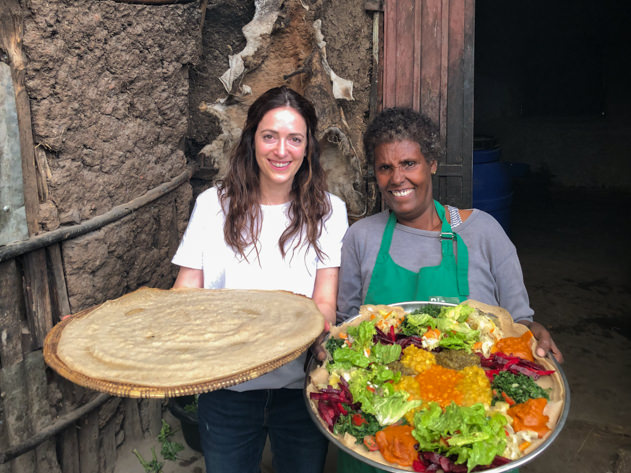
Ethiopian food: coffee, injera and much more
If you’re wondering what the most popular food in Ethiopia is, my short answer would be injera (a staple flatbread) and buna (coffee).
Ethiopians love eating injera (a sourdough spongy flatbread the size of a pizza pan that goes with pretty much anything you can think of, from sauces and stews to meat) every day. They do so by using their hands when sharing this traditional food from communal plates. Note that injera is made from a highly nutritious grain called teff, making this Ethiopian dish a true superfood and a very filling and healthy one!
Because of religious observance, the Ethiopian cuisine is mainly vegan. To be honest with you, coming from Spain, I thought it would be difficult for me to hold two weeks eating fully vegan and without even trying pork. But surprisingly, the experience of eating injera mostly every single day was easier than I expected. 🙂 And most of the times, you can find pasta in restaurants in case you feel like eating something ‘different’ (the most popular options are pasta beu atkilt – with vegetables – and pasta beu siga – with meat-; not quite like eating pasta in Italy, but they do the trick).
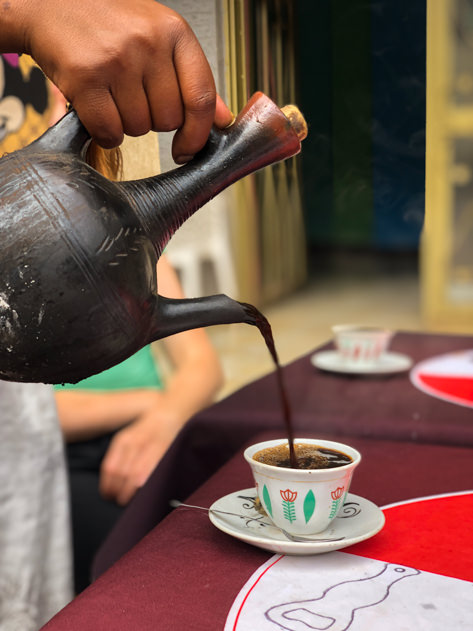
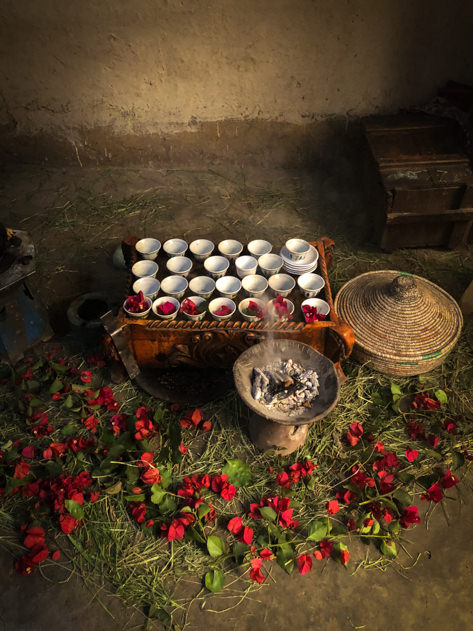
Also, be ready to drink lots of the famous Ethiopian coffee called buna! Considered as the birthplace of coffee, it should come as no surprise that drinking it is a deeply-rooted tradition among locals in Ethiopia. As a matter of fact, Ethiopians place high importance on their buna ritual, which is a traditional coffee ceremony to show respect and hospitality to family and friends. It always involves a female figure who first spreads fresh grass and flowers on the floor and table, before burning incense. While the aroma fills the room, she roasts, grinds and brews the coffee beans. Finally, the coffee is served in small cups (you’re normally expected to drink three of them), along with snacks such as ambasha (a sweet flatbread), bobolino (fried dough bread similar to a donut), kolo (roasted barley) or popcorn. Sometimes, you might also find rue (a herb known as ´tena´adam´) next to your cup of coffee; it´s said to remove any bitterness from your drink. As you can see, the buna coffee ritual is a great occasion to catch up with both loved ones and new acquaintances! And the traditional coffee pots made of clay are so cute, I actually bought one as a souvenir.
In terms of food, other traditional Ethiopian dishes include the following:
- Asa: spicy fish, usually Nile perch.
- Beyaynetu (also spelled bayenetu or beyainatu): it’s a combination platter displaying various vegetarian options from curries and stews to vegetables. You will find this dish widely in the country, although it is typically served on Wednesdays and Fridays, when Orthodox Christians fast and abstain from eating animal products, or during Lent.
- Chechebsa (also known as kita fir-fir): this breakfast dish consists of shredded injera flatbread, Berbere spice blend, onions, and a spiced clarified butter called niter kibbeh. It can also be served with honey and yoghurt.
- Doro wat (also spelled as doro wot): spicy chicken stew, which also includes a boiled egg.
- Gomen: a mix of collard green jazzed up with spices.
- Kitfo: minced meat (usually beef), typically served raw.
- Shiro: smooth and comforting stew made from powdered chickpeas or lentils, often mixed with minced onions, garlic, and Berbere spice.
- Tibs: chunks of sautéed and stir-fried meat (be it beef, chicken, goat or lamb).
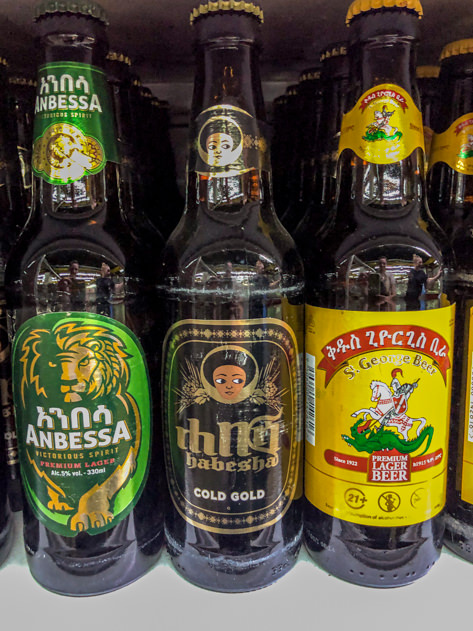
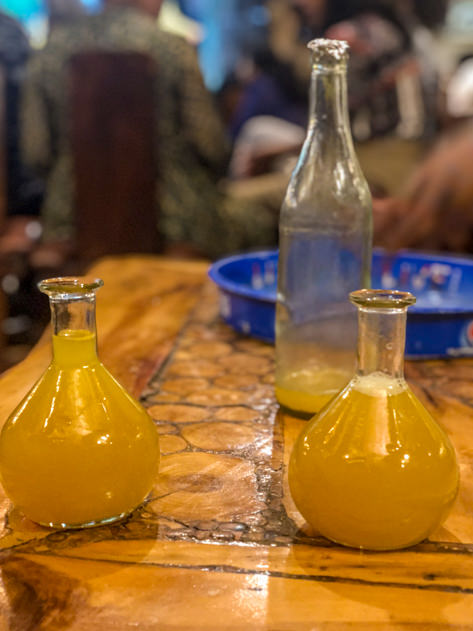
Last but not least, let’s cover some beloved national drinks. Spris would be the equivalent of smoothies, although healthier as they feature layered pureed fruit. You’ll find plenty of Ethiopian beers throughout the country too, the most popular brands being Anbessa, Bedele, Habesha, Harar or St George. Finally, the honey wine (known as tej) is another local’s favorite which sort of reminded me of cider back home in the Basque Country.
When visiting Ethiopia, an experience that I can definitely recommend is taking a cooking class with a local. We did so with a lovely lady called Sisko in Lalibela, where we cooked an injera and some other traditional sauces with her daughters. She uses her house as a restaurant called Unique. This is for sure one of my fondest memories of our Ethiopia trip, and I would love to do this kind of culinary experience in other destinations around the world. Certainly a great way to immerse yourself in any given culture!
Is it safe to travel to Ethiopia?
In my humble opinion, I found the country was a safe destination and locals were very friendly and welcoming. That being said, traveling to Ethiopia can be challenging and requires careful preparation due to the nation’s complex security situation.
Here are some key points to consider:
- In terms of security concerns, you may encounter regional conflicts and civil unrest in some parts of the country. For example, when we visited Ethiopia, we were advised not to travel to Aksum, lying in the northern province of Tigray. Note that the security situation can deteriorate rapidly, and violence can erupt without warning. There’s also a threat of landmines and terrorism, particularly in border regions and crowded public places.
- Regarding crime, take into account that petty crimes such as pickpocketing, purse snatching, and theft from vehicles are common, especially in Addis Ababa and other major cities. Violent crime, though less frequent, does occur. Visitors should be vigilant, avoid displaying signs of wealth, and refrain from walking alone, particularly after dark.
In short, make sure to monitor the security situation before traveling to Ethiopia and reach out to your national Embassy or Consulate regarding the latest information on the ground. As women visiting the country, we felt completely safe, also because we were always accompanied by trusted guides and/or locals.
How much does it cost to travel to Ethiopia?
After this 2-week itinerary across Ethiopia, you might be wondering how much it cost me. To be honest with you, although the country itself is cheap compared to Western standards, getting there, visiting the main sites or going on safaris and guided tours can be quite costly. However, I can guarantee you it’s a once-in-a-lifetime experience that you’ll cherish forever!
To give you a better sense of my budget for Ethiopia, let me break down the costs below:
- Domestic flights from Addis Ababa to Lalibela (86 USD)
- Guided tours in Lalibela and the Ethiopian south, including accommodation, a driver, a travel guide and rangers in national parks as well as meals (around 2.000 USD in total per person; 200 USD for Lalibela, 1700 USD for the southern leg of the trip and 100 USD in tips).
- Personal expenses such as eating out in Addis, souvenirs and so on (200 USD)
- Round trip international flights from Spain to Turkey and then to Ethiopia (860 USD)
- Travel insurance with Mondo (57 USD) covering the two weeks in Ethiopia and with a 5% discount. Essential for peace of mind!
- Tourist visa fee (82 USD)
- Typhoid vaccine shot, malaria pills and mosquito repellent for both the skin and clothes (92 USD)
TOTAL: 3.377 USD
How to get an Ethiopian visa?
Before traveling to Ethiopia, you should apply for a visa through this official website. If you’re visiting for leisure, you should select the tourist visa. Depending on your travel plans, you can opt for the single entry 30 days (which costs $82 and is the one I applied for; my e-visa was approved in less than 24 hours!) or the multiple entry for 90 days.
Note that visa conditions should be checked carefully, and overstaying can result in fines. Also, ensure your passport is valid for at least six months beyond your intended stay.
Finally, the official Ethiopian visa website provides some useful information about historical places and festivals to visit in the country as well.
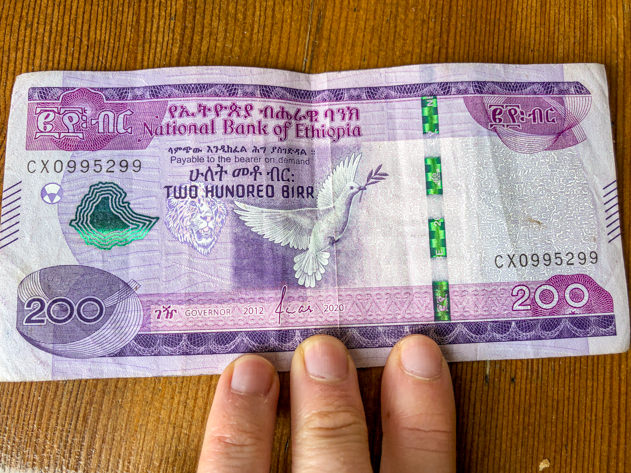
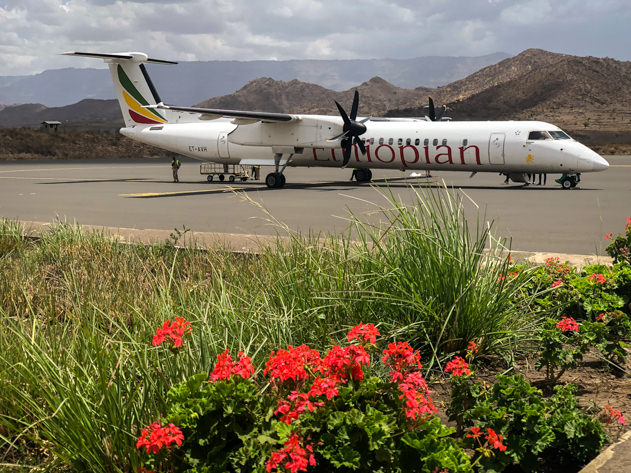
Travel tips: communication, currency, getting around, photography gear and travel resources
Below I have listed some topics that could be of interest before traveling to Ethiopia:
- Communication: note that mobile and Internet connectivity can be unreliable, so plan accordingly and inform relatives of your travel itinerary. During our trip, we experienced power outages and poor Internet connection various times. You may buy a local SIM card while you’re there.
- Currency: Ethiopian birr (ETB) is the currency in the country. Check the current exchange rate from USD dollar to birr and vice versa here. It’s recommended to carry US dollars as they are more widely accepted for exchange (that’s what we used to pay our guides during the trip). Credit cards are accepted in major hotels and some establishments in Addis Ababa, but cash is essential, especially when exploring rural areas outside the capital.
- Getting around: during our 2-week itinerary throughout Ethiopia, we mainly used two modes of transportation, namely airplanes and cars. We flew domestically from Addis to Lalibela with Ethiopian Airlines, which is the national carrier and a well-established one, not only in the country but also around the world. But above all, we spent a LOT of hours in the car, especially when exploring southern Ethiopia. In our experience, most roads were badly paved or literally dirt roads (even though the Chinese are building lots of them), and you will see plenty of people and animals on them in addition to vehicles (it actually reminded me a lot about Pakistan). We were lucky to have our driver Aki, who took us around safely using just his memory (no Google Maps here!).
- Photography gear: in case you would like to capture memorable pictures when visiting Ethiopia, you can take a macro lens for photographing animals and birds in the national parks, along with a portrait lens when visiting tribes or admiring landscapes.
- Travel resources: to plan your next trip to Ethiopia you may use these guidebooks (Bradt or Lonely Planet) as they include plenty of helpful information. You can also get inspired by Joan’s itinerary from the blog Against the Compass, during which he also covered the Simien Mountains and the Danakil Depression in addition to the attractions I mentioned above.

What kind of clothes should I wear in Ethiopia?
As in many parts around the world, clothing is a significant element of the culture. In the particular case of Ethiopia, you will notice a distinctive scarf or shawl. This two-layered cotton cloth is called netela for women and gabi for men. The most popular design involves borders of coloured embroidered woven crosses.
In Ethiopia, men are advised to wear long trousers and a shirt or T-shirt covering the shoulders, whereas for women, long shirts and dresses or trousers that cover the shoulders and knees are ideal. When entering religious sites such as churches, it is advised to cover your hair.
In case you’ll be doing a safari during your visit to Ethiopia, that clothing piece of advice remains true. I suggest you pack long sleeve shirts and pants as well as trekking shoes to protect yourself from mosquitoes, mud, fallen branches and the like. Also, game drives (excursions to see wildlife) tend to take place early in the morning or before sunset, so layering up is always a good idea.
Should you need some inspiration for what to wear in a safari, you can shop the look below based on the Decathlon products I used during my trip.
What time and year is it in Ethiopia? And what’s with the Ethiopian calendar?
Given its geographical location, Ethiopia is on the East Africa time (EAT) zone, which is UTC+03. This means that there are no daylight savings or clock changes during the year. However, Ethiopians have a different way of counting time because they use 12-hour cycles (from dawn to dusk, and then from dusk to dawn). According to Ethiopian standards, the day starts at 6AM, hence 7AM would be the first hour, 8AM would be the second hour and so on. On the other hand, 7PM would be the first hour of their ‘evening / night’. This system is still widely used among some African tribes!
But surprisingly, there’s another fun fact that you might be curious to learn about. Because of the difference in the calculation of the birth date of Jesus, Ethiopians place this historic moment in 7 BC (before Christ). That is why the Ethiopian calendar, also known as Ge’ez, is seven or eight years behind the Gregorian calendar we use in the Western world. In addition to a year with 12 months (and 30 days in each month), they have an additional 13th month called Pagume that only lasts five or six days and is added at the end of every year to match the calendar to the solar cycle. To give you an idea, as per the Ethiopian calendar, the new millennium (our year 2000) started at midnight on September 12, 2007!
When is the best time to travel to Ethiopia?
Ethiopia’s climate varies significantly across different regions. While in the south-eastern and north-eastern lowlands, the climate is typically tropical with mean annual temperatures ranging from 25-30°C, in the large central highland regions, the climate is much cooler with average annual temperatures around 15-20°C.
In case you’re wondering when is the best time to visit Ethiopia, October to March is an ideal period given the generally pleasant weather with less rainfall and moderate temperatures. This is precisely when most Ethiopian Orthodox festivals are celebrated, including Leddet / Genna on January 7th, which would be the equivalent of Ethiopian Christmas, or Timkat which symbolizes the baptism of Jesus in the River Jordan and takes place on January 19th. The two major Muslim celebrations include Eid al-Fitr (marking the end of Ramadan) and Eid al-Adha (the Feast of Sacrifice).
Note that the rainy season usually takes place from June to September. Despite the heavy rainfall, you might find discounts because of fewer travelers.
As a reference, we traveled to Ethiopia during the months of March and April, coinciding with the end of the dry season. We had nice weather throughout our stay, with a few showers towards the end, when we visited the south of the country. I fondly remember our first night at Chebera-Churchura National Park, where we spent about an hour in complete silence watching the storm from our cabins! It was such a priceless experience and a powerful reminder of the forces of nature.
Where is Ethiopia?
Ethiopia is a vast and very diverse landlocked country located in the Horn of Africa and split by the Great Rift Valley. It borders other African nations such as Djibouti, Eritrea, Kenya, Somalia, South Sudan and Sudan.
Ethiopia has a lot to offer, from ancient heritage like the UNESCO rock-hewn churches of Lalibela or archaeological finds dating back more than 3 million years and fascinating culture (take the Omo Valley tribes for example), to breathtaking landscapes and wildlife in national parks.
However, Ethiopia doesn’t receive as many international tourists as other more popular African countries, including Botswana, Egypt, Morocco or South Africa. Being an underrated travel destination translates in less crowded attractions, but also in poorer tourism infrastructure.
In case you would like to learn more about the country, from its population, currency and language to its typical food, you can refer to my Ethiopia destination page. I even included a list with some useful Amharic words that may come in handy while you’re visiting! 🙂
Which vaccines are required to enter Ethiopia?
A few months ahead of traveling to Ethiopia, I suggest you check with your home country’s travel advisories about the required vaccinations. In my case, I had to get booster shots for yellow fever and typhoid fever. It’s advisable to carry your vaccination certificates, as airlines and local authorities may request them upon arrival to your destination.
Furthermore, be aware of the health risks, including food poisoning and waterborne diseases. It’s important to take precautions like drinking bottled water and ensuring food is well-cooked. Also, make sure to stock up on medicines ahead of your trip to Ethiopia. For example, I carried anti-diarrheal tablets or mosquito repellent in my suitcase, and I’m glad I did as I had an upset stomach twice!
For extra peace of mind, you can calculate how much you would pay for your health insurance with the SafetyWing widget below.
All in all, visiting Ethiopia was an incredible experience filled with stunning landscapes, rich history, and diverse cultures. Whether you’re exploring the bustling capital city of Addis, visiting the rock-hewn churches of Lalibela, trekking through national parks, or interacting with local tribes, the country offers a unique and unforgettable adventure.
How did you like this post detailing our 2-week Ethiopia itinerary? I hope you found it helpful and it inspired you to visit soon. In case you have any questions, feel free to leave a comment below!
***
✈️ Curious to know where I’ll be traveling next? ✈️
Stay tuned by following me on social media (Facebook, Instagram, X) and subscribe to my newsletter for regular updates!
In the meantime, safe travels around the world!
***
| GET READY FOR YOUR NEXT TRIP! |
|---|
| Browse my travel resources page to plan your upcoming trip. |
| Feeling adventurous? Book any outdoor activities worldwide with Manawa! |
| Get medical or health insurance via SafetyWing for extra peace of mind. |
| Looking for sports equipment? Feel free to browse my Decathlon profile for inspiration. |
| Use the Anaya Touring or Lonely Planet travel guidebooks to plan your trip. They’re really comprehensive and helpful! |
| Create travel memories you’ll never forget! Book things to do, attractions and tours around the world with Get Your Guide. |

